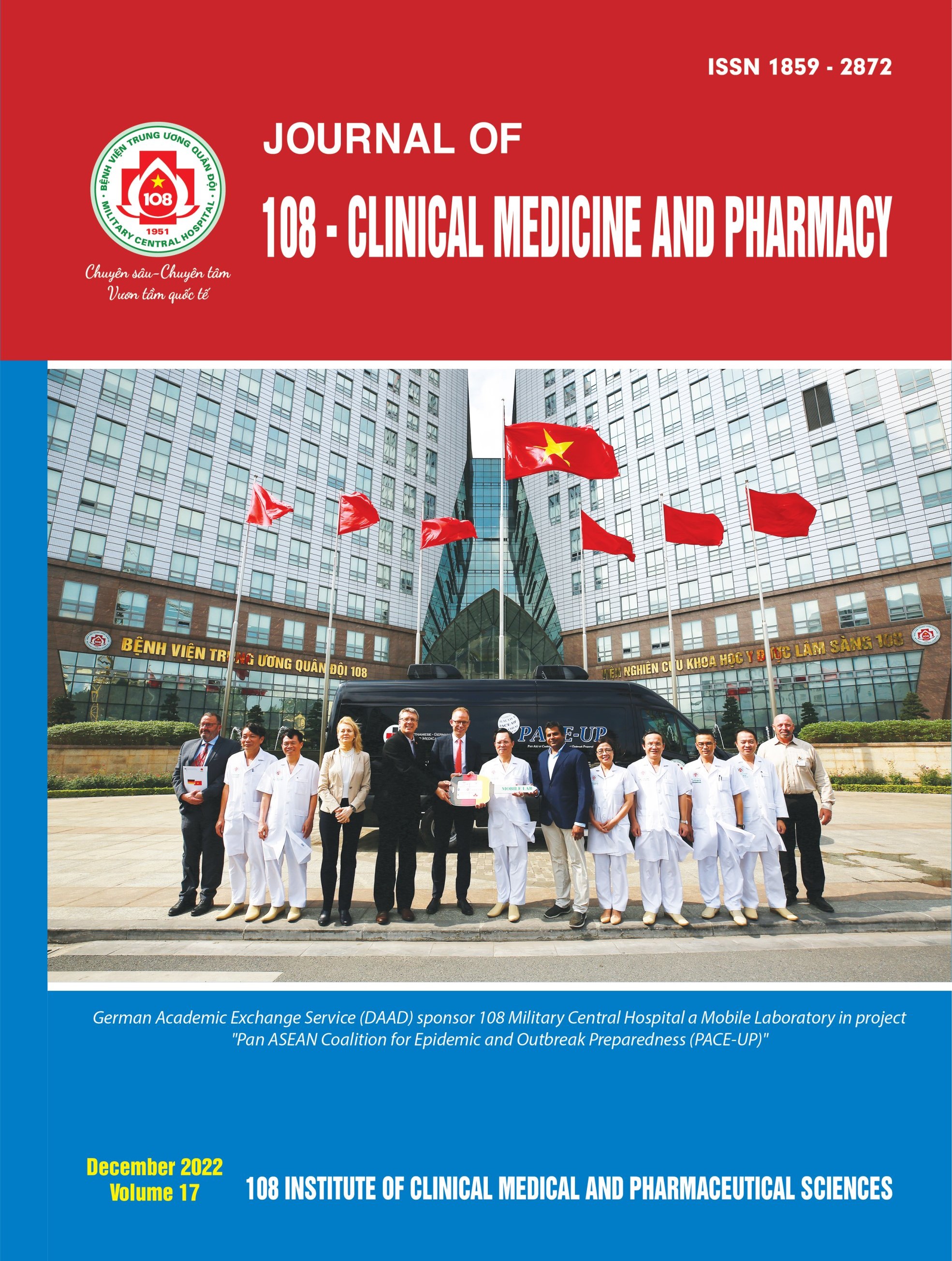Association of surgical treatment with functional outcome in patients with spontaneous cerebellar hemorrhage
Main Article Content
Tóm tắt
Objective: To investigate the relation of surgical treatment with patient’s 180-day outcome. Subject and method: Thirty-six patients who suffered a first spontaneous cerebellar hemorrhage (SCH) were treated with operation from January 2017 to March 2022. This study aimed to identify potential clinical and computed tomography (CT) features influencing outcomes after 6 months from ictus, and the association of surgical treatment with SCH patients. Result: The mean age was 62.9 years (IQR 43–83 years). Hypertension was the most common underlying disease (31 patients, 86.1%), followed by smoking (15 patients, 41.7%). 63.9% (23/36) of patients showed loss of consciousness at the initial presentation. Among 36 patients, 25 patients (70%) underwent surgical hemorrhage evacuation with placement of an external ventricle drainage (EVD), 4 patients (10.4%) received an EVD only. The six-moth mortality rate was 33.33%, 12 patients (33.34%) had good outcome (modified Rankin Scale – mRS < 3). In multivariate analysis only the Glasgow coma scale (GCS) score and intracerebral hemorrhage (ICH) score on admission was significant predictor of six-month outcome ([odds ratio (OR) = 1.50, 95% confidence interval (CI): 1.08-2.08, p=0.01; OR = 0.32, CI: 0.10–1.05, p=0.03), respectively. Conclusion: Surgical treatment can be effective for selected patients without lower GSC scores on admission. However, a higher ICH score on admission was associated with a 180-day outcome in patients with SCH.
Article Details
Các tài liệu tham khảo
2. Ferro JM (2006) Update on intracerebral haemorrhage. Journal of neurology 253(8): 985-999.
3. Al Safatli D, Guenther A, McLean AL, Waschke A, Kalff R, Ewald C (2017) Prediction of 30-day mortality in spontaneous cerebellar hemorrhage. Surgical neurology international 8: 282.
4. Broderick J, Connolly S, Feldmann E, Hanley D, Kase C, Krieger D et al (2007) Guidelines for the management of spontaneous intracerebral hemorrhage in adults: 2007 update: A guideline from the American Heart Association/American Stroke Association Stroke Council, high blood pressure research council, and the quality of care and outcomes in research interdisciplinary working group. Stroke 38(6): 2001-2023.
5. Kirollos RW, Tyagi AK, Ross SA, Van Hille PT, Marks PVJN (2001) Management of spontaneous cerebellar hematomas: A prospective treatment protocol. Neurosurgery 49(6): 1378-1386; discussion 1386-7. doi: 10.1097/00006123-200112000-00015.
6. Loon J, Van Calenbergh F, Goffin J, Plets C (1993) Controversies in the management of spontaneous cerebellar haemorrhage. A consecutive series of 49 cases and review of the literature. Acta neurochirurgica 122(3-4): 187-193.
7. Koziarski A, Frankiewicz E (1991) Medical and surgical treatment of intracerebellar haematomas. Acta neurochirurgica 110(1-2): 24-28.
8. Chang CY, Lin CY, Chen LC, Sun CH, Li TY, Tsai TH, et al (2015) The predictor of mortality within six-months in patients with spontaneous cerebellar hemorrhage: A retrospective study. PloS one 10(7):0132975.
9. Wijdicks EF, St Louis EK, Atkinson JD, Li H (2000) Clinician's biases toward surgery in cerebellar hematomas: an analysis of decision-making in 94 patients. Cerebrovascular diseases (Basel, Switzerland) 10(2): 93-96.
10. Hackenberg KA, Unterberg AW, Jung CS, Bösel J, Schönenberger S, Zweckberger K Does suboccipital decompression and evacuation of intraparenchymal hematoma improve neurological outcome in patients with spontaneous cerebellar hemorrhage? Clinical neurology and neurosurgery 155: 22-29.
11. Tsitsopoulos PP, Tobieson L, Enblad P, Marklund N (2012) Prognostic factors and long-term outcome following surgical treatment of 76 patients with spontaneous cerebellar haematoma. Acta neurochirurgica 154(7): 1189-1195.
12. Brott T, Thalinger K, Hertzberg V (1986) Hypertension as a risk factor for spontaneous intracerebral hemorrhage. Stroke 17(6): 1078-1083.
13. Louis EK, Wijdicks EF, Li H, Atkinson JD (2000) Predictors of poor outcome in patients with a spontaneous cerebellar hematoma. The Canadian journal of neurological sciences Le journal canadien des sciences neurologiques 27(1): 32-36.
14. Pong V, Chan KH, Chong BH, Lui WM, Leung GK, Tse HF et al (2012) Long-term outcome and prognostic factors after spontaneous cerebellar hemorrhage. Cerebellum (London, England) 11(4): 939-945.
15. St Louis EK, Wijdicks EF, Li H (1998) Predicting neurologic deterioration in patients with cerebellar hematomas. Neurology 51(5): 1364-1369.
16. Dolderer S, Kallenberg K, Aschoff A, Schwab S, Schwarz S (2004) Long-term outcome after spontaneous cerebellar haemorrhage. European neurology 52(2): 112-119.
17. Wu YT, Li TY, Chiang SL, Chu HY, Chang ST, Chen LC (2013) Predictors of first-week mortality in patients with acute spontaneous cerebellar hemorrhage. Cerebellum (London, England) (2): 165-170.
18. Appelboom G, Hwang BY, Bruce SS, Piazza MA, Kellner CP, Meyers PM et al (2012) Predicting outcome after arteriovenous malformation-associated intracerebral hemorrhage with the original ICH score. World neurosurgery 78(6): 646-650.
 ISSN: 1859 - 2872
ISSN: 1859 - 2872
